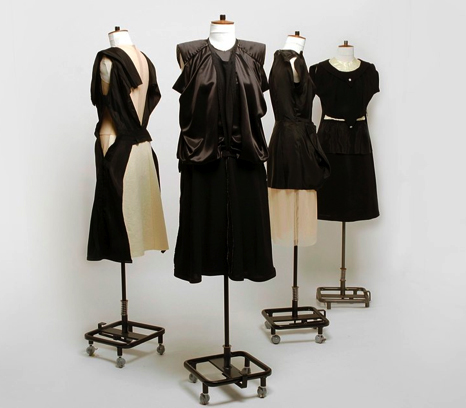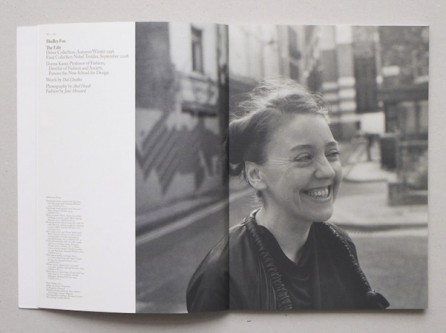2012
Shelley Fox
Published in Archivist Zero
The designer Shelley Fox has been living in-between two cities for the past four years. London – the backdrop to her formative years at Central Saint Martins where she was a student of fashion and textiles between 1990 and 1996 – and the urbane metropolis that is New York, where she is now the Director of the MFA Fashion Design and Society program at Parsons. All Fox has been doing lately is thinking about her belongings. “There is nothing like moving country to force you to throw stuff away. It really makes you focus in on what is important,” she says describing the process of emptying the London house she owns with partner, the artist, Ross Tibbles and downsizing to a rental in Manhattan. “All we have now are our books, Ross’s artwork and two boxes of my clothes. Now I know why New Yorker’s are so obsessed with closet space – it’s because they don’t have any!” she smiles.
Whilst editing her archive, Fox only saved pieces from her last four collections, uninterested in creating an exacting collection of her work as a designer between 1997 and 2004. “The pieces from my last few collections were really intensely made, all the burnt sequin collection, the big frills collection and I’ve got two pieces from my MA collection, which I still love. I have kept all the museum type pieces, but I still managed to get rid of a lot and feel quite proud of myself for doing that,” she pauses. “I remember speaking to a designer friend of mine who was quite horrified about it but…they’re just clothes! Eventually they will rot because I can’t archive them in the right way. I’m not a museum.” If she misses anything, it is the collection of vintage clothing she used to wear growing up in the early eighties; her closet rammed with relics from the thirties and forties, “I would pick up the most beautiful forties tops for 50 Pence so I had an enormous archive of proper vintage pieces and I think that’s where I understood construction in clothing. That’s where I learnt about how fabric hangs. I don’t have any of those clothes now because I moved around so much as a student. I used to have this huge, round shop rail in a room, which I shared with my friend Kath and it was full of fifties ball gowns and thirties tea dresses. I don’t know where it all went.”
Early on in her career, Fox poured over the medical archives at the Wellcome Institute on Euston Road, which went on to underline her signature use of fabrics more often seen in medical and geosynthetic industries. “I used to go to look at the photography archives at the Imperial War Museum, which is a fascinating place. For my spring/summer 2001 military collection, I went to Bletchley Park, which was where thousands of people worked during the war to decode German military transmissions and pass messages onto intelligence centres. When I was doing early collections, I was more obsessed with medical archives and fabrication, I don’t think I ever looked at fashion libraries.”
Fox’s own archive – once relegated to her brother’s barn in Lincolnshire in the north of England – is now reduced and with her finally in New York (along with Tibbles). The process of editing her belongings was cathartic. “In 2003, when I was leaving the studio on Andrews Road, I literally went around the room and I stuck pieces of paper on everything with pound signs on what was for sale and I put a big poster in the elevator saying come and grab stuff. It’s all for sale. People were taking the sewing machines, the cupboards, the tables and I knew that that stuff could be replaced so I didn’t care. Then I started going through my patterns and got rid of what I thought was a lot then. Each time I would visit my brother I would think ‘oh I don’t need that anymore, I can get rid of it’, it was almost like a relinquishing, you know, I don’t need this I can get rid of it, and the last time we did it was this year.” Editing nine huge boxes down to two and a half, she kept her patterns but only in one size, she says, “in terms of my archive, I’ve become less precious about that. I went through all the boxes and thought, what can I let go of and what am I attached to? There was so much I wasn’t attached to.”
Perhaps the designer has been ‘New Yorked’ – any sentimental British compassion replaced with a harder, no-nonsense approach to material possessions. In 1998, a year before she won the Jerwood Prize she told The Guardian, “when you run your own business, you have to be quite tough. I don’t want to be a one hit wonder” but today she seems less frustrated. “I’m not in the middle of collections anymore, sampling, production, going to Paris or wondering if I’m going to have a business next year and honestly, I feel a bit more resolved and I feel a distance from my business as it was then. I don’t feel bitter about not doing my collections anymore, I just found a better way for me to be creative.”
“When I went through the collection I thought I would be able to go through it quickly, but you don’t, you go through some of the pieces and it takes you back to the studio you were at, the interns that you had and even if it was a miserable time and you thought you hated the collection at the time, it’s often one of your strongest. What we would do is work on a collection, the timing would be miserable, the collection worked on after I won the Jerwood, the sequin frill collection, was one of my favourite but making it was one of the most depressing times. We changed the collection two weeks before the show – completely – and so now when I look at those pieces, they remind me that you have to take risks.”
Winning the Jerwood Prize was a significant moment in Fox’s career, it put her on the map, provided her with funds to pay off some debts and saw her collection on sale in famed London department store Liberty for two seasons, but sooner or later, the hype would die down and looking back, Fox wasn’t prepared for that. “It was such a big thing, but it came with a lot of pressure that I don’t know I handled that well. I didn’t really start showing collections until my sixth season – just before I won the Jerwood. When you consider that now people show as soon as they graduate, it’s mad! It was a rocky start for me, it was such a cottage industry, the way I was doing it back then and London allowed that – time to discover what you were about before showing yourself off. I’m not that obsessed with having my own label anymore.”
It was in 2003 when Fox made the decision to close her business, for the sake of her sanity. “I did go through that thing of thinking that everyone is judging me… but then recently I have spoken to a lot of my contemporaries, people I was working with back then, who have all told me that they were in the same boat. Actually, when I stopped, I started to get approached by lots of people to do projects with them. I was approached almost right away to do ‘Fashion at Belsay’”, an installation staged in a 19th century house in Northumbria alongside other British designers such as Alexander McQueen and Stella McCartney, “I was busy, but in a different way - it was much more enjoyable.”
Right now for what she is lacking in space, working at Parsons has afforded Fox the time to think longer about the projects she wants to undertake. “Getting older, you start to hold on to things less romantically because life’s too short to be bogged down with stuff, but…” she smiles, “there are some things I don’t want to let go of.” Unpacking her things in New York recently she came across her collection of the first one hundred issues of The Face magazine – gold dust to anyone with an interest in cultural anthropology and clothes – only to consider chucking them out. ‘I was so busy at work and I didn’t feel like I had time to unpack everything and move in properly. I felt trapped and I said to Ross, “I’m going to sell these! I’m in New York! We have no space! IT’S DRIVING ME MAD!” And then the next day I realised that that wasn’t the best idea I’ve ever had. I was just going mad about the lack of space,’ she beams, ‘maybe we just need to move to Brooklyn.’





